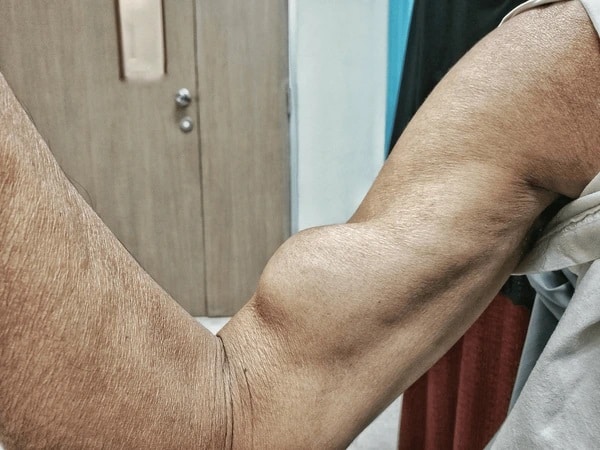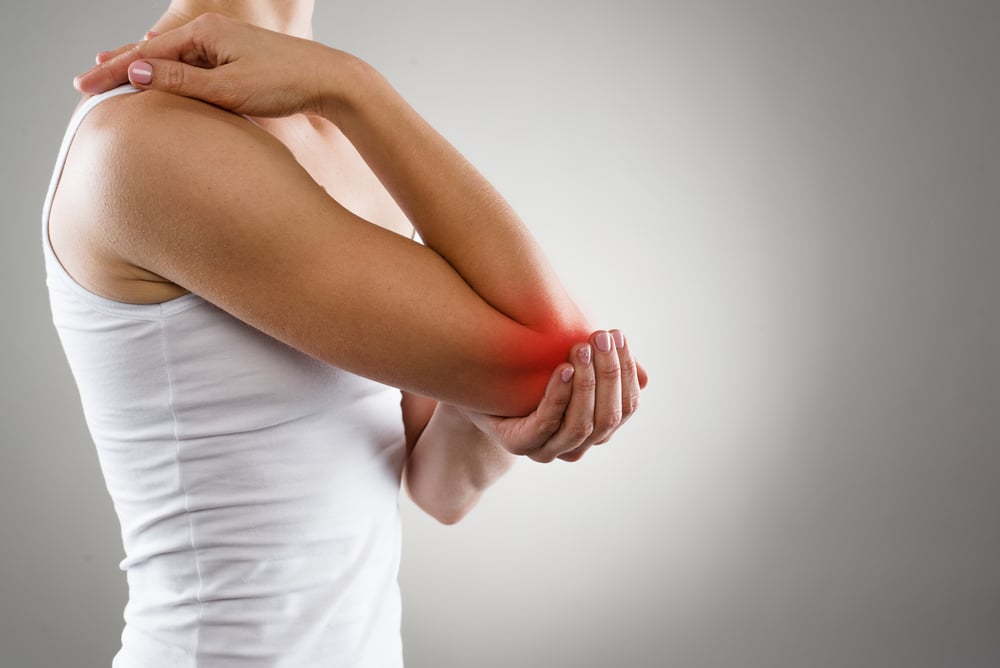This website uses cookies so that we can provide you with the best user experience possible. Cookie information is stored in your browser and performs functions such as recognising you when you return to our website and helping our team to understand which sections of the website you find most interesting and useful.


A biceps tendon tear is an injury involving the rupture or partial tearing of the tendon that attaches the biceps muscle to the elbow joint or shoulder. The biceps muscle has two tendons, one that connects to the shoulder (long head) and one to the elbow (short head). Tears can occur in either of these tendons, but tears of the long head tendon are more common.
Biceps tendon tears can result from various factors, including:
Trauma: Acute trauma or sudden forceful movements, such as lifting heavy objects or falling on an outstretched arm, can cause a tear in the biceps tendon.
Chronic Overuse: Repetitive overhead motions or activities that place strain on the biceps tendon, such as weightlifting, throwing sports, or certain occupational activities, can lead to gradual wear and tear of the tendon, increasing the risk of tears over time.
Age-related Changes: As people age, the tendons in the body become less flexible and more prone to degeneration. This natural aging process can make the biceps tendon more susceptible to injury, particularly in individuals over 40.
Pre-existing Conditions: Certain conditions, such as rotator cuff tears, shoulder impingement syndrome, or tendinitis, can weaken the surrounding structures and increase the risk of biceps tendon tears.
Steroid Injections: Prolonged or frequent use of corticosteroid injections in the shoulder joint can weaken the tendon and make it more prone to tears.
Sudden Pain: Many patients with a biceps tendon tear report experiencing sudden, sharp pain in the shoulder or elbow at the time of injury. The pain may be intense initially and then gradually subside or become more persistent over time.
Pain with Movement: Pain in the shoulder or elbow may worsen with specific movements or activities that involve using the biceps muscle, such as lifting, reaching overhead, or bending the arm.
Weakness: in the affected arm, particularly with activities that require strength or gripping, is common with biceps tendon tears. Patients may notice difficulty lifting objects, performing daily tasks, or participating in sports or physical activities.
Tenderness and Swelling: The area around the shoulder or elbow joint may be tender to the touch, and swelling or inflammation may be present, especially near the front of the shoulder or inside the elbow.
Popping Sensation: Some patients may hear or feel a popping or snapping sensation at the time of injury, particularly if the tendon ruptures completely.
Visible Deformity: In cases of severe biceps tendon tears, the biceps muscle may retract or bunch up, resulting in a bulge or deformity in the arm. This is often referred to as a “Popeye” deformity due to the appearance of the biceps muscle.
Limited Range of Motion: Reduced range of motion in the shoulder or elbow joint may occur, especially with attempts to bend or straighten the arm fully. Stiffness or tightness in the affected joint may also be present.
Crepitus: Some patients may experience a sensation of grinding, clicking, or popping in the shoulder or elbow joint during movement, known as crepitus.


Call Us Today To Make An Appointment.
Treatment for biceps tendon tears depends on the severity of the injury, the patient’s activity level, and their overall health.
Options may include:
- Rest, ice, compression, and elevation (RICE) to reduce pain and swelling.
- Physical therapy exercises to improve strength, flexibility, and range of motion in the affected arm.
- NSAIDs or other pain-relieving medications to manage discomfort.
- Corticosteroid injections to reduce inflammation (although caution should be exercised due to their potential to weaken tendons).
- Surgical repair, especially for complete tears or tears that significantly impair function, may be necessary in some cases.
Biceps tendon tear repair surgery is a procedure performed to reattach or reconstruct a torn biceps tendon in the shoulder or elbow. It is typically recommended for patients with significant biceps tendon tears that cause pain, weakness, and functional limitations, especially if conservative treatments have not provided adequate relief.
The specific surgical technique used to repair a biceps tendon tear depends on various factors, including the location and severity of the tear, the patient’s overall health, and their activity level. However, there are generally two primary surgical approaches for repairing biceps tendon tears:
Open Repair: In an open repair procedure, where Dr. Pournaras will make an incision over the affected area, typically in the front of your shoulder or elbow, to access the torn biceps tendon. The torn tendon is then reattached to its original attachment point using sutures or special anchors secured into the bone. If the tendon is severely damaged or retracted, Dr. Pournaras may need to use additional techniques, such as tendon grafting, to reconstruct the tendon or stabilize the joint
Arthroscopic Repair: Arthroscopic surgery is a minimally invasive approach that uses small incisions and specialized instruments to repair the torn biceps tendon. During an arthroscopic repair, Dr. Pournaras will insert a tiny camera called an arthroscope into the joint to visualize the torn tendon and surrounding structures. Tiny surgical instruments are inserted through additional incisions to reattach the tendon using sutures or anchors. Arthroscopic techniques offer several potential benefits, including smaller incisions, less postoperative pain, faster recovery, and reduced risk of complications compared to open surgery.
After biceps tendon repair surgery, patients typically undergo rehabilitation to restore strength, flexibility, and range of motion in the affected shoulder or elbow. Physical therapy exercises are often prescribed to gradually reintroduce movement and strengthen the repaired tendon while minimizing re-injury risk.
It’s important to note that the success of biceps tendon repair surgery depends on various factors, including the size and location of the tear, the patient’s overall health, and adherence to postoperative rehabilitation protocols. As with any surgical procedure, there are potential risks and complications associated with biceps tendon repair surgery, such as infection, nerve injury, stiffness, or re-tearing of the tendon. Therefore, patients considering surgery should discuss the potential benefits and risks with Dr. Pournaras to make an informed decision about their treatment options.
Biceps tendon tears can result from various factors, including acute injuries and chronic overuse.
Common causes of biceps tendon tears:
Acute Trauma: A sudden forceful movement or traumatic event can cause a tear in the biceps tendon. This can occur during activities such as lifting heavy objects, participating in contact sports, or falling onto an outstretched arm. Direct impact to the elbow or shoulder region can also lead to tendon tears.
Repetitive Overuse: Chronic overuse or repetitive stress on the biceps tendon can weaken the tendon over time, making it more susceptible to tears. This is common in individuals who engage in activities or occupations that involve repetitive arm motions, such as weightlifting, throwing sports (e.g., baseball, javelin), overhead work (e.g., painting, construction), or activities that require frequent lifting or pulling.
Age-related Degeneration: As people age, the tendons in the body naturally become less elastic and more prone to degeneration. This can make the biceps tendon more susceptible to injury, especially in individuals over the age of 40 or those with pre-existing degenerative changes in the tendon.
Poor Lifting Technique: Improper lifting techniques, such as lifting objects with excessive force or using incorrect body mechanics, can place excessive strain on the biceps tendon and increase the risk of injury.
Previous Injuries: Patients who have previously experienced injuries to the shoulder or elbow joint, such as rotator cuff tears, shoulder impingement syndrome, or tendinitis, may be at a higher risk of developing biceps tendon tears due to weakened or compromised tendon structures.
Steroid Injections: Prolonged or frequent use of corticosteroid injections in the shoulder joint to manage inflammation or pain can weaken the tendon and make it more susceptible to tears.
Underlying Medical Conditions: Certain medical conditions, such as rheumatoid arthritis, gout, or hyperparathyroidism, can affect the health of the tendons and increase the risk of tendon tears.
Anabolic Steroid Use: Misuse or abuse of anabolic steroids, which are often used to enhance athletic performance or promote muscle growth, can weaken tendon structures and increase the risk of tears.
It’s essential to note that while these factors can contribute to the development of biceps tendon tears, the exact cause may vary from patient to patient. Seeking prompt medical evaluation and appropriate treatment is crucial for a patient experiencing symptoms of a biceps tendon tear to prevent further damage and facilitate recovery.
General steps and considerations for biceps tendon tear recovery:
Medical Evaluation: The first step in the recovery process is to seek medical evaluation. Our highly trained medical staff will assess the extent of the biceps tendon tear through a physical examination, imaging tests (such as MRI), and other diagnostic procedures.
Treatment Decision: Based on the evaluation findings, Dr. Pournaras will recommend an appropriate treatment plan. Depending on factors such as the severity of the tear, the individual’s symptoms, and their activity level, treatment options may include conservative (non-surgical) management or surgical repair.
Conservative Management: If the biceps tendon tear is partial or if the patient is not experiencing significant symptoms, conservative treatment may be recommended. This typically involves rest, activity modification, pain management (such as NSAIDs or corticosteroid injections), and physical therapy exercises to strengthen surrounding muscles and improve joint function.
Surgical Repair: For patients with complete or severe biceps tendon tears, surgical repair may be necessary to reattach or reconstruct the torn tendon. The specific surgical technique used will depend on factors such as the location and extent of the tear, the patient’s age and activity level, and overall health. After surgery, a period of immobilization, followed by a structured rehabilitation program, is typically prescribed to promote healing and restore strength and function in the affected arm.
Rehabilitation: Whether managed conservatively or surgically, rehabilitation plays a crucial role in recovering from a biceps tendon tear. Physical therapy exercises are prescribed to improve range of motion, strength, flexibility, and stability in the affected shoulder or elbow joint. The rehabilitation program is tailored to the patient’s specific needs and gradually progresses as the tendon heals and regains function.
Gradual Return to Activity: As the tendon heals and strength improves, the patient can gradually resume activities and sports, following the physical therapist’s guidance. Progressing gradually is essential to avoid re-injury and allow the tendon to fully heal.
Long-term Management: Even after recovery, patients with a history of biceps tendon tear should continue with appropriate strength and conditioning exercises, maintain good posture and body mechanics, and avoid activities that place excessive stress on the affected joint to prevent recurrence of injury.
Mon 8:00 am – 4:30 pm
Tue 8:00 am – 4:30 pm
Wed 8:00 am – 4:30 pm
Thu 8:00 am – 4:30 pm
Fri 8:00 am – 4:30 pm
Sat Closed
Sun Closed

